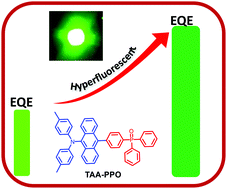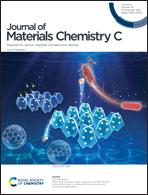High performance non-doped green organic light emitting diodes via delayed fluorescence†
Abstract
Non-doped, delayed fluorescence organic light-emitting diodes (OLEDs) provide a route to high performance devices and simplified device fabrication. Here, two ambipolar anthracene derivatives containing a hole-transporting di-p-tolylamine and a carbazole and an electron-transporting phosphine oxide moiety are rationally designed and synthesized. The thermal and optoelectronic properties were investigated and the neat films of these compounds show high photoluminescence quantum yields of 84–87%. Non-doped OLEDs with these luminogens exhibit green emission at ∼545 nm and an EQEmax of over 7.2% due to the delayed fluorescence resulting from triplet–triplet annihilation (TTA). The devices show a high luminance of over 104 400 cd m−2. Power efficiency and current efficiency maxima are up to 23.0 lm W−1 and 28.3 cd A−1, respectively. Moreover, the devices show very low efficiency roll-off and retain 90% of the maximum efficiency even at 20 000 cd m−2. When combined with a thermally activated delayed fluorescent (TADF) assistant dopant, the green-emitting OLEDs show a high EQEmax of 17.8%.

- This article is part of the themed collections: Showcasing recent research in materials chemistry from IIT Bombay, IIT Indore and IISc and 2021 Journal of Materials Chemistry C most popular articles


 Please wait while we load your content...
Please wait while we load your content...